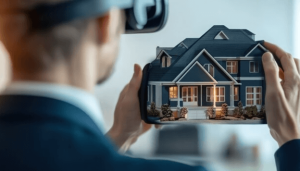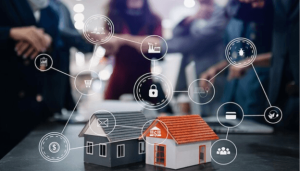This is not one of those Mad Men moments where we pull out some fantastic campaign that changes everything. But frankly, it is a total game-changer. For anyone looking to sell their property, virtual tools are redefining the real estate sector with detailed holograms, projection mapping and smart control systems. It’s more than just a 360-degree virtual tour of your home. It’s an immersive experience packed with endless interactive tools, completely reshaping urban planning as we know it. Real estate and virtual reality tools are now working together like never before, helping with clearer visualisations, faster transactions and a happier you.
With everything going AI, how could the real estate industry still get stuck with boring spreadsheets?
Click, Tour, Sold: How Virtual Tours are Revolutionising Property Showings
Virtual tours here will give buyers the experience of a lifetime they deserve. Using advanced technology, clients can walk through hallways, peek inside closets, step out onto balconies, and even decorate furniture. These are all without travelling for hours and having awkward conversations with real estate agents during the showing.
Rather than limiting your view to just daytime or nighttime, immerse yourself in how the home feels throughout various times of the day using virtual reality in real estate. These showings are available on many platforms, synced with a complete VR and real estate set-up, offering high-quality images instead of grainy videos. Virtual tours make life so much easier for people by providing a clear view of the exact floor plan and even tweaking it to fit your family’s needs.
So, think of a virtual tour as your golden ticket- unlocking a world of real estate possibilities where every investment is just a click away.
AR in Property Visualisation: Build Your Home Even Before You Own It

AR (Augmented Reality) tools are similar to Virtual Reality tools, helping customers experience their home’s lifestyle and features before living in it. However, AR is slightly better than the latter as it offers more than just a 360-degree view of your dream home. It can help alter floor plans and stage the entire property in a completely redefined way. It might also be accessed using any simple mobile application instead of requiring a whole VR setup.
This immersive experience provides an actual layout in all ways possible, alters every space element and even redevelops the entire project without moving from your couch. In layman’s terms, you are the HGTV expert of your own home regarding virtual reality in real estate. One of the biggest advantages of AR is that it allows you to model an entire house in an under-construction space and change the outlook of the space in an instant. They can try out different furniture arrangements or even change materials like flooring or countertops, designing a space that fits their style and needs.
AR saves time and money while offering a thorough look at potential homes. This is one of the reasons why properties associated with these tools lead to quicker sales and fewer property showings that go nowhere. So, AR has become one of the key elements seamlessly bridging real estate and virtual reality, making property visualisation more engaging and accessible.
Pixel Perfect Properties: Boosting Appeal Through Virtual Staging
![]()
Through VR and real estate integration, agents can fill a home with modern furniture, stylish décor, and carefully chosen colour schemes, helping potential buyers visualise the space’s full potential. Virtual staging can help people purchase properties in under-construction homes, selecting various styles and themes for the rooms and common spaces. It also helps them analyse the overall construction and renovation budget, providing an even more accurate cost analysis.
Virtual stages use only 3D models of all furniture and decor pieces in a pre-staged environment, helping them picture how the space can align with their tastes. It removes the guesswork and sparks the imagination, which is crucial in assisting buyers in making faster, more confident decisions.
The Future of Real Estate Marketing: Will Virtual Reality Change It All?
Real estate marketing traditionally focused heavily on location and lifestyle quality, relying on these factors as primary selling points for far too long. These included widespread E-mail or social media campaigns to reach agents and clients. Now, with the inclusion of virtual tours into property listings, investors living all across the globe can look at any property without any hassle.
This immersive experience of virtual technologies in real estate can also lead to quicker decision-making and a stronger emotional connection to the property. VR experiences can be developed to be easy to navigate. With technology, one can explore properties without frustration. VR experiences can also be offered for free in open houses or large events, allowing people to renovate or completely reconstruct the property.
Seamless Solutions and Strategies: How Virtual Technologies Improve Client Experience?

Virtual technologies in real estate enhance client experiences completely by providing immersive, interactive, and personalised solutions to each problem. By providing a 360-degree view of each room and space, VR and AR help attract customers from all walks of life and worldwide. According to some sources, properties offering virtual tours receive 87% more views than those without any such features.
More than 65% of buyers strongly prefer properties that offer virtual tours, and 54% of clients won’t even consider viewing a house or commercial space without these virtual tools. Listings with such virtual tours close 31% faster than other properties and are sold 9% over the average selling cost.
These statistics prove that clients are much more inclined towards properties offering virtual reality in real estate, such as holograms or projection mapping. This also allows them to take advantage of the property’s infrastructural insights. Therefore, it ensures the space is well-maintained and has all the necessary water lines and electrical systems.
How Virtual Tools Lead to Cost Reduction and Productivity in Real Estate Transactions?
Incorporating virtual technologies in real estate industry can significantly reduce costs and enhance efficiency for all parties involved. Even simple transitions, such as adopting virtual tours, can help reach a more dynamic audience and reduce traditional real estate Client Acquisition Cost of $200 to $300. They also manage the operational expenses of running real estate firms more efficiently and effectively.
The enhanced client engagement tools available inside the virtual tools and holograms have an average viewing duration of 10 minutes, and one in every five interested citizens will enquire about the property listing. Other than that, developers and brokers can manage their properties much better by regularly checking the electrical systems and water lines using virtual reality in real estate.
How has technology changed the real estate industry?

Virtual reality in real estate is completely revamping the real estate industry, allowing buyers to “suit up” their homes from anywhere in the world. These virtual tools, helping in both urban and house planning, can identify investment opportunities and personalise property recommendations for clients. This data-driven approach enables real estate professionals to make informed decisions, optimise pricing strategies, and enhance customer satisfaction.
It seems that in the future, all aspects of real estate will be regulated and monitored by such virtual tools. From everyday tasks like controlling the HVAC systems to reducing the risk of fraud via blockchain-powered smart contracts, AI will perhaps eliminate the need for any third parties. Investors will also be able to integrate the urban planning maps and the property’s location, helping evaluate its real-time value and make future forecasts based on the same.
Virtual Technologies in Real Estate: Challenges and Limitations
Virtual technologies in real estate, while helpful to developers, cost a lot to implement and might need huge investment for every little modification being made to the property in real time. Any form of AR or VR being used for property listings requires high-speed internet, VR headsets, and powerful devices, which can limit the market reach to certain urban areas only.
Sometimes, people can also experience certain glitches during virtual tours with some inaccurate layouts, which might prevent the property from being sold for a long time. As real estate increasingly relies on digital platforms, the industry becomes more vulnerable to cyber threats. While larger organisations can address these issues promptly, smaller ones may require additional time to identify and resolve potential vulnerabilities, ensuring their clients’ data remains secure and protected from breaches.
Real Estate’s Upgrade: From “Location, Location, Location” to “Connection, Connection, Connection”
Real estate’s modern approach to selling properties is more like flipping through portals in the Multiverse. Clients have never held this much power while making any property-related investment, from staging the entire property to seeing the holograms of their desired project even before owning it. From routine maintenance to major renovations and even full property reconstructions, AI tools empower all parties involved in a real estate and virtual reality transaction to determine fair and profitable figures for everyone. Even though these tools are expensive, they ultimately boost customer satisfaction and attract a larger pool of potential clients.
Frequently Asked Questions
Question 1- How is virtual technology reshaping the real estate market?
Answer- Virtual technology is revolutionising the real estate market by enabling immersive experiences like virtual tours, allowing buyers to explore properties remotely. It streamlines transactions, reduces operational costs, and broadens market reach, all within a couple of minutes.
Question 2- How does AR enhance the real estate experience?
Answer- Augmented Reality enhances the real estate experience by overlaying digital elements onto real-world spaces, helping clients visualise furniture layouts, design changes, and property features, ensuring regular maintenance and upkeep.
Question 3- What is the role of Proptech in real estate?
Answer- Proptech refers to all the applications and platforms that link real estate to digital tools like AI, VR, and data analytics, streamlining processes such as property management, transactions, and client engagement.
Question 4- How has technology changed the real estate industry?
Answer- Technology has made transactions faster, more efficient, and accessible to a global audience with its automated processes and virtual tools that ultimately enhance property viewing and management experiences.
Question 5- What is a digital reality?
Answer- Digital reality refers to technology-driven platforms and infrastructure that support data centres, cloud services, and digital ecosystems essential for modern businesses. These help in maintaining digital transactions and smart buildings.

